CNRS researcher at LPTMC, Sorbonne Université
e-mail: aurelien (dot) grabsch (at) sorbonne-universite.fr

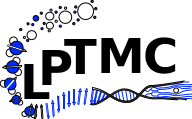

- Full stochastic dynamics of a tracer in a dense single-file system
Alexis Poncet, Aurélien Grabsch, Olivier Bénichou
arXiv:2505.21446 - Exact large-scale correlations in diffusive systems with general interactions: explicit characterisation without the Dean--Kawasaki equation
Aurélien Grabsch, Davide Venturelli, Olivier Bénichou
arXiv:2504.08560 - Dynamics of soft interacting particles on a comb
Davide Venturelli, Pierre Illien, Aurélien Grabsch, Olivier Bénichou
J. Phys. A 58 215001 (2025)
arXiv:2502.16951
- Tracer and current fluctuations in driven diffusive systems
Théotim Berlioz, Olivier Bénichou, Aurélien Grabsch
Phys. Rev. Lett. 134, 247101 (2025)
arXiv:2412.14661 - Universal scale-free decay of spatial correlations in d-dimensional interacting particle systems
Davide Venturelli, Pierre Illien, Aurélien Grabsch, Olivier Bénichou
arXiv:2411.09326 - Current fluctuations in the symmetric exclusion process beyond the one-dimensional geometry
Théotim Berlioz, Davide Venturelli, Aurélien Grabsch, Olivier Bénichou
J. Stat. Mech. (2024) 113208
arXiv:2407.14317 - Semi-infinite simple exclusion process: from current fluctuations to target survival
Aurélien Grabsch, Hiroki Moriya, Kirone Mallick, Tomohiro Sasamoto, Olivier Bénichou
Phys. Rev. Lett. 133, 117102 (2024)
arXiv:2404.18481 - Tracer diffusion beyond Gaussian behavior: explicit results for general single-file systems
Aurélien Grabsch, Olivier Bénichou
Phys. Rev. Lett. 132, 217101 (2024)
arXiv:2401.13409
- Joint distribution of currents in the symmetric exclusion process
Aurélien Grabsch, Pierre Rizkallah, Olivier Bénichou
SciPost Phys. 16, 016 (2024)
arXiv:2307.02374 - From Particle Currents to Tracer Diffusion: Universal Correlation Profiles in Single-File Dynamics
Aurélien Grabsch, Théotim Berlioz, Pierre Rizkallah, Pierre Illien, Olivier Bénichou
Phys. Rev. Lett. 132, 037102 (2024)
arXiv:2306.13516 - Exact spatial correlations in single-file diffusion
Aurélien Grabsch, Pierre Rizkallah, Alexis Poncet, Pierre Illien, Olivier Bénichou
Phys. Rev. E 107, 044131 (2023)
arXiv:2302.02929
- Driven tracer in the Symmetric Exclusion Process: linear response and beyond
Aurélien Grabsch, Pierre Rizkallah, Pierre Illien, Olivier Bénichou
Phys. Rev. Lett. 130, 020402 (2023)
arXiv:2207.13079 - Duality relations in single-file diffusion
Pierre Rizkallah, Aurélien Grabsch, Pierre Illien, Olivier Bénichou
J. Stat. Mech. (2023) 013202
arXiv:2207.07549 - Exact time dependence of the cumulants of a tracer position in a dense lattice gas
Alexis Poncet, Aurélien Grabsch, Olivier Bénichou, Pierre Illien
Phys. Rev. E 105, 054139 (2022)
arXiv:2202.09278
- General truncated linear statistics for the top eigenvalues of random matrices
Aurélien Grabsch
J. Phys. A 55 124001 (2022) for the special issue Emerging Talents 2021
arXiv:2111.09004 - Exact closure and solution for spatial correlations in single-file diffusion
Aurélien Grabsch, Alexis Poncet, Pierre Rizkallah, Pierre Illien, Olivier Bénichou
Sci. Adv. 8, eabm5043 (2022)
arXiv:2110.09269 - Generalized Correlation Profiles in Single-File Systems
Alexis Poncet, Aurélien Grabsch, Pierre Illien, Olivier Bénichou
Phys. Rev. Lett. 127, 220601 (2021)
arXiv:2103.13083
- Half-integer charge injection by a Josephson junction without excess noise
F. Hassler, A. Grabsch, M.J. Pacholski, D.O. Oriekhov, O. Ovdat, I. Adagideli, C.W.J. Beenakker
Phys. Rev. B 102, 045431 (2020)
arXiv:2005.08655 - Wigner-Smith matrix, exponential functional of the matrix Brownian motion and matrix Dufresne identity
A. Grabsch, C. Texier
J. Phys. A: Math. Theor. 53 425003 (2020)
arXiv:2002.12077
- Localization landscape for Dirac fermions
G. Lemut, M. J. Pacholski, O. Ovdat, A. Grabsch, J. Tworzydło, C.W.J. Beenakker
Phys. Rev. B 101, 081405(R) (2020)
arXiv:1911.04919 - Dynamical signatures of ground-state degeneracy to discriminate against Andreev levels in a Majorana fusion experiment
Aurélien Grabsch, Yevheniia Cheipesh, Carlo W.J. Beenakker
Adv. Quantum Technol. 2019, 1900110
arXiv:1909.08335 - Distribution of the Wigner-Smith time-delay matrix for chaotic cavities with absorption and coupled Coulomb gases
Aurélien Grabsch
J. Phys. A 53(2) 025202 (2019)
arXiv:1909.01002 - Time-resolved electrical detection of chiral edge vortex braiding
I. Adagideli, F. Hassler, A. Grabsch, M. Pacholski, C.W.J. Beenakker
SciPost Phys. 8, 013 (2020)
arXiv:1907.02422 - Pfaffian formula for fermion parity fluctuations in a superconductor and application to Majorana fusion detection
Aurélien Grabsch, Yevheniia Cheipesh, Carlo W.J. Beenakker
Ann. Phys. (Berlin) 2019, 1900129
arXiv:1903.11498
- Electrical detection of the Majorana fusion rule for chiral edge vortices in a topological superconductor
Carlo W.J. Beenakker, Aurélien Grabsch, Yaroslav Herasymenko
SciPost Phys. 6, 022 (2019)
arXiv:1812.01444 - Wigner-Smith time-delay matrix in chaotic cavities with non-ideal contacts
Aurélien Grabsch, Dmitry V. Savin, Christophe Texier
J. Phys. A 51(40) 404001 (2018) (Special issue Random Matrices: the first 90 years)
arXiv:1804.09580 - Correlations of occupation numbers in the canonical ensemble and application to BEC in a 1D harmonic trap
Olivier Giraud, Aurélien Grabsch, Christophe Texier
Phys. Rev. A 97, 053615 (2018)
arXiv:1802.02555
- Fluctuations of observables for free fermions in a harmonic trap at finite temperature
Aurélien Grabsch, Satya N. Majumdar, Grégory Schehr, Christophe Texier
SciPost Phys. 4, 014 (2018)
arXiv:1711.07770 - Extremes of 2d Coulomb gas: universal intermediate deviation regime
Bertrand Lacroix-A-Chez-Toine, Aurélien Grabsch, Satya N. Majumdar, Grégory Schehr
J. Stat. Mech. (2018) 013203
arXiv:1710.06222
- Truncated linear statistics associated with the eigenvalues of random matrices II. Partial sums over proper time delays for chaotic quantum dots
Aurélien Grabsch, Satya N. Majumdar and Christophe Texier
J. Stat. Phys. 167(2) 1452–1488 (2017)
arXiv:1612.05469 - Truncated linear statistics associated with the top eigenvalues of random matrices.
Aurélien Grabsch, Satya N. Majumdar and Christophe Texier
J. Stat. Phys. 167(2), 234-259 (2017)
arXiv:1609.08296 - Distribution of spectral linear statistics on random matrices beyond the large deviation function – Wigner time delay in multichannel disordered wires.
Aurélien Grabsch and Christophe Texier
J. Phys. A 49 465002 (2016)
arXiv:1602.03370
- Topological phase transitions in the 1D multichannel Dirac equation with random mass and a random matrix model.
Aurélien Grabsch and Christophe Texier
Europhys. Lett. 116, 17004 (2016)
arXiv:1506.05322
- Capacitance and charge relaxation resistance of chaotic cavities - Joint distribution of two linear statistics in the Laguerre ensemble of random matrices.
Aurélien Grabsch and Christophe Texier
Europhys. Lett. 109, 50004 (2015)
arXiv:1407.3302
- One-dimensional disordered quantum mechanics and Sinai diffusion with random absorbers.
Aurélien Grabsch, Christophe Texier and Yves Tourigny
J. Stat. Phys. 155(2), 237-276 (2014)
arXiv:1310.6519
Keywords: statistical physics, interacting particle systems, stochastic processes, large deviations, condensed matter theory, random matrix theory, topology in condensed matter, Majorana zero modes, disordered systems
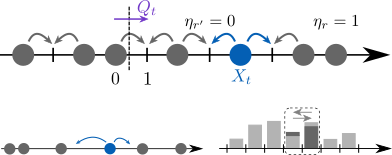 |
I am interested in the physics of single-file systems. These are systems in which particles cannot bypass each other. Following the dynamics of a tracer particle, we observe a subdiffusive behaviour, which originates from strong bath-tracer correlations. Focusing on paradigmatic models of single-file diffusion, such as the Simple Exclusion Process (SEP), I use analytical tools (master equations, large deviations, ...) to characterise the bath-tracer correlations. In turn, the knowledge of these correlations allow to fully characterise the dynamics of the tracer particle. |
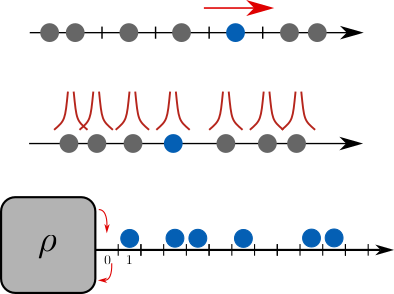 |
From the study of these paradigmatic models, I aim to obtain general laws that apply to more general or realistic models, including driven systems, arbitrary interactions or different geometries. |
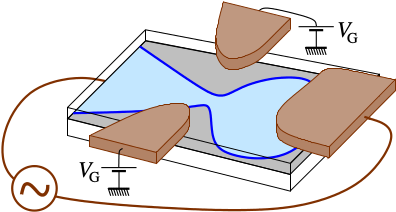 |
I am also interested in the applications of random matrix theory (RMT) to statistical physics, and in particular to quantum transport. For instance, the complex dynamics of chaotic cavities, like quantum dots, can be well described by a statistical approach. This consists in taking a random scattering matrix to characterize transport through the system. Many relevant physical quantities (like conductance, resistance,...) can be expressed in terms of the eigenvalues of the scattering matrix, or related matrices. |
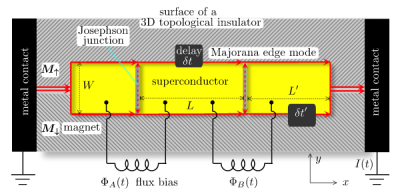 |
During my first postdoc, I worked on topological properties of condensed matter systems. Topological superconductors can support Majorana zero-modes (midgap states bound to a defect). These zero modes have non-Abelian statistics: they are neither bosons nor fermions, and can be used for the realisation of topologically protected quantum computations. Topological superconductors also possess non-Abelian excitations of the chiral edge modes: the edge vortices. Unlike the Majorana zero-modes which are fixed, the edge vortices have the advantage of propagating along the chiral edge modes. I am investigating the possibility to demonstrate the non-Abelian nature of the edge vortices, and their possible use for the realisation of topologically protected quantum computations. |
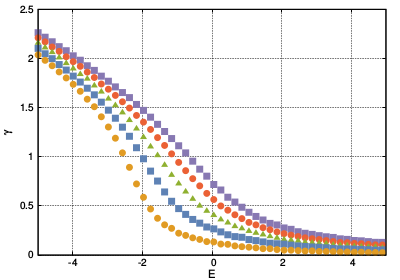 |
I am also interested in disordered systems. It is well known that wave functions in 1D in a random potential are localized (Anderson localization). The localization length have been computed for diverse models of disorder. However the 2D case is still out of reach. I mostly focus on models of multichannel disordered wires which describe an intermediate situation, using matrix Langevin equations. |
- Since 2022: CNRS researcher (chargé de recherche) at LPTMC
- 2020-2022: Postdoc at LPTMC, Sorbonne Université (Paris)
With Olivier Bénichou
- 2018-2020: Postdoc at the Lorentz Institute for theoretical physics (Leiden, Netherlands)
In the group of Carlo Beenakker
- PhD Thesis (defended in 2018): Random Matrix Theory in Statistical Physics: Quantum Scattering and Disordered Systems
Under the supervision of Christophe Texier and Satya Majumdar

Enseignements à Sorbonne Université :
- TD+TP de Mécanique Physique (L1), 2023-
Enseignements à l'Université Paris-Sud :
- Cours-TD de physique quantique (L3), 2015-2018
- L3 physique et applications Site du cours
- TD Programmation et données numériques (M1), 2015-2017
- M1 physique appliquée Site du cours





 orcid.org/0000-0003-4316-5190
orcid.org/0000-0003-4316-5190